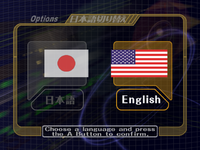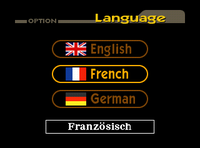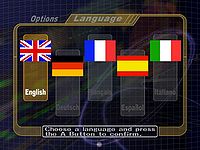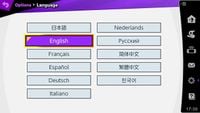Language
Language is an option found in the Options menu on the PAL version of Super Smash Bros., all versions of Super Smash Bros. Melee and Super Smash Bros. Ultimate, and determined by system settings in the PAL version of Super Smash Bros. Brawl and all versions of Super Smash Bros. 4. As the name suggests, the player can adjust the language of their copy of the game.
In Super Smash Bros.[edit]
The original Super Smash Bros. is available in five languages: Japanese, English, French, German, and Simplified Chinese. The Simplified Chinese version of the game is available on the iQue Player, the Chinese export of the Nintendo 64, and was released a few years after Melee.
Language can only be adjusted in the European version of SSB; it can be set between three languages through an extra section on the options menu: English, French, and German. When the player hovers over a menu item in the Japanese, French, or German versions, a white box with its corresponding translation will display at the bottom of the screen. The Simplified Chinese version of the game is fully translated into the language, and is mainly based on SSB's English version (though some Pokémon characters have unique voice clips).
SSB introduced some types of speaking characters who continue to appear in future entries. One type is characters with language-neutral voice clips and/or short bits of English dialogue, like Yoshi and Captain Falcon. Another type is Pokémon with "Cries" from their Pokémon the Series appearances like Pikachu and Snorlax; Pikachu in particular was not allowed to actually talk,[1] and "cries" for some Pokémon can vary by region. A third type is characters with Japanese dialogue exclusive to certain releases; in SSB, Fox's line for one of his victory poses is only in the Japanese version. Additionally, the announcer shares voice lines in the Japanese and English versions and is dubbed in French and German, though the German version does not have unique voice clips for "Captain Falcon", "Computer Player" or "Team Battle".
In Super Smash Bros. Melee[edit]
Super Smash Bros. Melee is available in six languages: Japanese, English, French, German, and two languages making their debut: Italian and Spanish. Japanese is only available in the NTSC versions while the four other languages (French, German, Italian, and Spanish) are only available in the PAL versions. When the English language setting is active in NTSC versions, the "Language" option is written in Japanese.
In the PAL version, when languages other than English are selected, most of Melee is still in English save for most "simple" text. Furthermore, despite the presence of the British flag on the English option, the text is largely unchanged from the NTSC English version, and does not take the language's regional differences into account. Additionally, all the voice clips are reused from the NTSC English version in all languages (other than some Pokémon and Jigglypuff's announcer calls in the German and French versions).
Melee introduced a few firsts with its speaking characters. It is the first Smash entry with characters that speak either Japanese or English depending on which version is played; the characters in question are Fox, Falco, Peppy, and Slippy from the Star Fox series. It is also the first internationally-released Nintendo game with characters that only speak Japanese; those in question are Marth and Roy from the Fire Emblem series. Finally, it is the first Smash entry with a Pokémon character that speaks a human language, with it being Mewtwo. Mewtwo and Sheik speak Japanese in their victory quotes in Melee's Japanese version, but their dialogue is either muted or dubbed over with generic grunts in other versions.
In Super Smash Bros. Brawl[edit]
Super Smash Bros. Brawl is available in seven languages: Japanese, English, French, Spanish, German, Italian, and for the first time in the series, Korean. NTSC versions can only be played in English, while PAL versions of Brawl can choose between five different languages (all aside from Japanese and Korean). The game's language is based off the Wii's system settings, and cannot be changed in-game. Japanese text that includes kanji is displayed with furigana, which is a reading system designed to help those who aren't familiar with kanji understand how they're supposed to be read, by displaying the hiragana symbols that spell the kanji symbol. All text is translated to the language of choice and the announcer and crowd chants are fully dubbed into each language, though the PAL versions mainly use characters' voices from the English version.
On top of adding more characters that speak both Japanese and English, Brawl was the first entry with characters that also speak five languages: French, German, Italian, Spanish, and Korean. They are Pokémon Trainer and Lucario, who are also the first Pokémon characters in Smash that speak languages other than Japanese. Meanwhile, Marth still only speaks Japanese and Mr. Resetti speaks "Animalese".
In Super Smash Bros. 4[edit]
Both versions of Super Smash Bros. 4 are available in nine languages: Japanese, English, French, Spanish, German, Italian, and for the first time Dutch, Portuguese, and Russian. Super Smash Bros. for Nintendo 3DS is additionally available in Korean while Super Smash Bros. for Wii U lacks the option because the Wii U console was never officially released in South Korea. The Pan-American version of both the Wii U and 3DS versions supports three languages: English, French, and Spanish while the European/Oceanian version supports eight, adding five other languages: German, Italian, Dutch, Portuguese, and Russian. Like in Brawl, the language used by the game depends on the language set on the system itself and cannot be changed in-game.
While the four languages (French, Spanish, German, and Italian) continue to dub over the announcer, crowd cheers, and some character voices, the other versions do not. The voice tracks in the Dutch, Portuguese, and Russian versions are from the British English version while those in the Korean version are from the Japanese version. Lucario, Sonic, Shadow, and Wii Fit Trainer can speak four languages: French, German, Italian, and Spanish in addition to two languages: Japanese and English. Meanwhile, Marth, Takamaru, the Prince of Sablé, Roy, and Cloud only speak Japanese in every version. The returning Mewtwo is the same as it was in Melee, language-wise.
In Super Smash Bros. Ultimate[edit]
Ultimate supports 11 languages regardless of region: Japanese, English, French, Spanish, German, Italian, Dutch, Russian, Korean, Simplified Chinese, and Traditional Chinese. Simplified Chinese is available for the first time since the original Super Smash Bros., and Traditional Chinese is entirely new to the series. However, Portuguese, which was present in SSB4, is no longer available, despite the Nintendo Switch system still having a Portuguese-language option and the game itself releasing in Portuguese speaking regions like Brazil. For the first time since Melee, the language selection is available from an in-game menu rather than being automatically selected based on the system's region and language settings. This is due to the Nintendo Switch not having region locking, necessitating every language to be available on the same physical Switch cartridge.
The Western-language versions tend to use characters' English voices, while the Asian versions typically use their Japanese voices. Exceptions in the Asian versions include Snake, Ryu and Ken being voiced in English in the Chinese and Korean versions, and Simon and Richter being voiced in English in the Korean version. Knuckles joins Sonic, Shadow, Lucario, Pokémon Trainer, and Wii Fit Trainer in being able to speak four languages: French, German, Italian, and Spanish. Meanwhile, Takamaru, the Prince of Sablé, Cloud, Yuri Kozukata, Akira Yuki, Sephiroth, and Kazuya only speak Japanese in every version. Newcomer Hero is similar to Mewtwo in that they speak Japanese in the Japanese version, but don't speak in other versions. The English/Japanese announcer, Xander Mobus, provides unique voice clips for the Korean version, while a mixture of his voice clips from both the English and Japanese versions are reused for both Chinese languages. New announcers also provide voice clips for the Dutch and Russian languages.
English, French and Spanish each have two different variants: a Pan-American variant (American English, Canadian French, and Latin American Spanish) and a European variant (British English, European French, and European Spanish). The difference is affected by the system's region and language, where the system's language often takes priority over its region. The chart below specifies which variant is used based on the system's settings:
| Language | English / French / Portuguese / Spanish | Japanese / Korean / Chinese |
German / Dutch / Italian / Russian | |||
|---|---|---|---|---|---|---|
| The Americas |
Japan | HK/TW/KR | EU / AUS/NZ | |||
| English | American | American | American | British | American | British |
| French | Canadian | European | European | European | Canadian | European |
| Spanish | Lat. Am. | Lat. Am. | European | European | Lat. Am. | European |
This effectively gives Ultimate a total of 14 language choices compared to the 11 selectable in the menu. Players can change the region in the Switch system settings to access these regional variants. On Nintendo Switch 2 the regional varieties of English, French and Spanish can freely be chosen without a specific console region, although the variety they get still depends on the other languages. In English, unlike in the previous game, only a few regional differences are still present, such as the name "Duck Hunt Duo" for Duck Hunt in European languages, the voices of Wii Fit Trainer depending on the region, tips describing characters' first appearances being accurate to the release date in the region, the Super Scope item being called the "Nintendo Scope", some slightly different music track names, Find Mii being called "StreetPass Quest", some spirit names being different, and games mentioned in the names of certain spirits and music tracks being named differently based on the region (such as "Wandering Samurai (Rhythm Heaven Fever)" in the Pan-American version differing from "Wandering Samurai (Beat the Beat)" in the European version). Other former differences, such as Boxing Ring character titles, spellings (such as color/colour and armor/armour), move names (such as Hammer Flip and Duck Jump), and text differing drastically have been standardized between English regional versions. The two Spanish and French versions, however, continue to exhibit significant text and character name differences, in addition to the Spanish voices for Wii Fit Trainer still differing between regions similarly to the English ones.
Unlike previous games, changing language settings in Ultimate reboots the game. As such, changing the language can be used as an alternate method (besides closing and reopening the game) to unlock characters in Smash battles more quickly by bypassing the 10-minute cooldown timer between challengers, particularly when using controllers that lack a HOME button.
Despite the game not being available in Portuguese and the official website lacking a Portuguese translation, official promotional content such as the Mr. Sakurai Presents/Battling With series has full Portuguese subtitles available on Nintendo's YouTube channel for Portugal.
Trivia[edit]
- In SSB4 and Ultimate, R.O.B.'s default costume depends on the language the game is set to. The Famicom colors are the default costume if the language is set between three languages: Japanese, Korean, or Chinese; otherwise, the NES colors are used, referencing how his real-life counterpart had different coloring between regions to match the NES/Famicom's body color.
- While the Asian versions share the announcer's voice actor in all games (except the Korean version of Brawl) with the English version, in Brawl, SSB4 and Ultimate, he pronounces some character names differently, namely those for King Dedede, Lucina, Simon, Richter and King K. Rool, to better reflect the Japanese pronunciation; Lucina, for example, is pronounced as "RU-ki-na" in Asian versions rather than "Lu-SEE-na" in the English version. However, Marth, Young Link, Lucas and Byleth do not share this trait (even in Melee), despite their Japanese pronunciations being slightly different from their English counterparts.
- In the Korean version of Ultimate, the announcer switches between English and Japanese pronunciations depending on the character.
- In Ultimate, Mewtwo does not speak in any of its victory poses if the language is set between four different languages: Spanish, German, Dutch or Russian. This is because the game loads up the voice scripts from the Japanese version, which uses separate voice clips from the English version.
References[edit]
| Super Smash Bros. menu items | |
|---|---|
| VS Mode | VS Start (Team Battle) · Rule · Time / Stock · VS Options |
| 1P Mode | 1P Game · Training Mode · Bonus 1 Practice · Bonus 2 Practice |
| Option | Sound · Screen Adjust · Backup Clear |
| Data | Characters · VS Record · Sound Test |
| Unused | Debug menu |
| Super Smash Bros. Melee menu items | |
|---|---|
| Vs. Mode | Melee (Time · Stock · Coin Battle · Bonus · Team Battle) · Custom Rules · Special Melee · Tournament Mode · Names |
| 1-P Mode | Regular Match (Classic Mode · All-Star Mode · Adventure Mode) · Event Match · Stadium (Target Test · Home-Run Contest · Multi-Man Melee) · Training |
| Trophies | Gallery · Collection · Lottery |
| Options | Rumble · Sound · Screen Display · Language · Erase Data |
| Data | Snapshots · Melee Records · Sound Test · Archives (NTSC only) · How to Play (PAL only) |
| Unused | Debug menu · Debug sound test menu |



